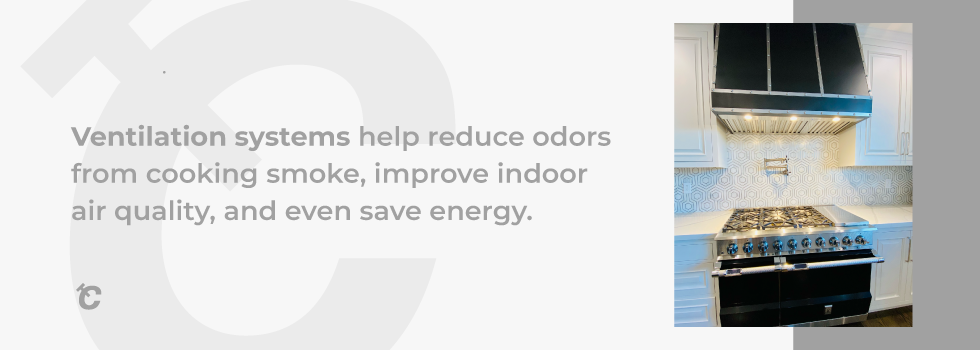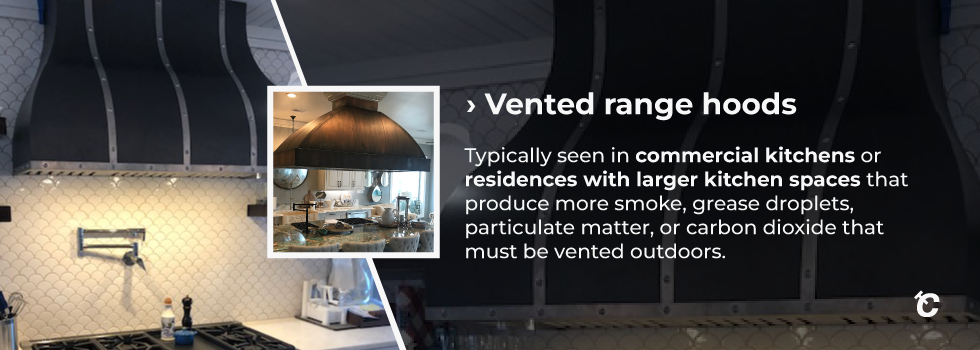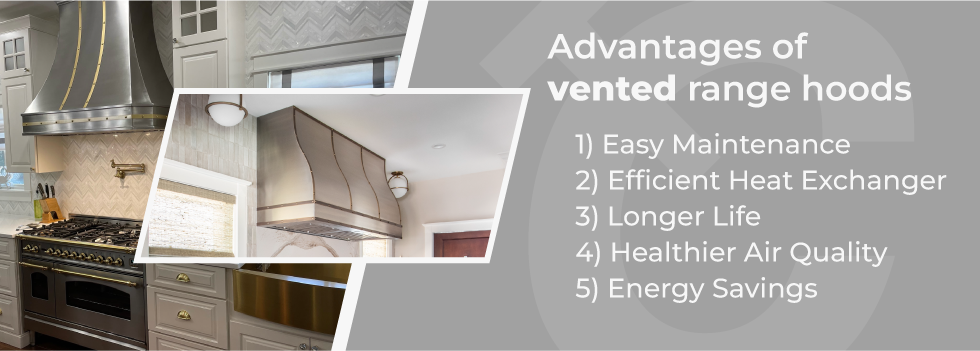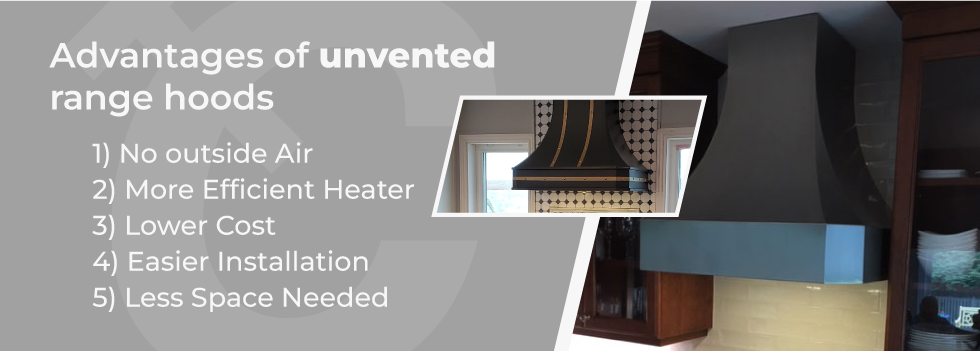
Ventilation systems are important components of your home. They help reduce odors from cooking smoke, improve indoor air quality, and even save energy.
In addition, they can also add value to your property and may even be mandatory, depending on the regulations on proper ventilation in your state.
Range hoods come in several shapes and sizes, including under-cabinet, wall-mounted, and ceiling-mount. They're designed to provide additional ventilation which goes beyond opening the kitchen window, keeping cooking smoke and grease out of kitchens while keeping heat inside.
Under-cabinet range hoods are usually placed near the sink where food prep takes place, and they typically mount onto the underside of a kitchen countertop.
Wall-mounted hoods hang above the stove and are often used in large kitchens. Ceiling-mounted hoods are positioned above stoves that sit on islands, tables, or even the tops of counters for optimum kitchen ventilation.
All of these styles include light fixtures that illuminate the cooktop.
Ventless vs. Vented Range Hoods
What's the difference between ventless and vented kitchen range hoods?
Vented range hoods

Vented range hoods, also known as ducted range hoods, are typically seen in commercial kitchens or residences with larger kitchen spaces that produce more smoke, grease droplets, particulate matter, or carbon dioxide that must be vented outdoors to ensure adequate air movement. These kinds of range hoods are also widely found in restaurants.
Ventilated hoods are superior to non-vented hoods in their ability to remove moisture and steam from the cooking area.
This is because vented hoods do not filter or recycle the air but instead vent it outside the kitchen.
A vented hood has very few disadvantages, but one of them is that it must be positioned in close proximity to a duct system that connects the inside of the kitchen to the exterior of the building or home.
Because of this, the regions of the kitchen in which you can position your range and hood may be restricted.
Advantages of vented range hoods

Vented range hoods have the following advantages:
1) Easy Maintenance:
You don't have to worry about clearing filters or grease issues, or replacing parts like with other types of hoods. Instead, the filter element is built right into the hood itself.
2) Efficient Heat Exchanger:
The heat exchangers in vented hoods are much better at transferring heat than those in non-vented hoods.
This means less energy is wasted heating up the air around the kitchen and makes this type of exhaust fan particularly appropriate for commercial kitchens or those which need an effective solution for removing significant levels of kitchen fumes.
3) Longer Life:
Vented hood units last longer than their non-vented counterparts because they do not need to be cleaned frequently, providing efficient mechanical ventilation for years to come.
4) Healthier Air Quality:
Vented hood systems help reduce indoor air pollution by removing harmful chemicals, cooking fumes, and particles from the air. They also remove moisture and humidity from the air, keeping it fresher and cleaner.
5) Energy Savings:
Vented hoods use less energy than non-vented models because they transfer heat efficiently.
Unvented range hoods

An unvented hood, or ductless range hood, has the benefit of being able to be used in a wider variety of situations and may be installed virtually anyplace.
In addition, a ductless exhaust hood does not require the installation of any pipe or ducts that are connected to the exterior of the home because all it does is filter and recirculate the air that is already present in the kitchen.
On the other hand, ventless range hoods have several drawbacks that must be considered. Because this hood does not bring in new air or expel stale cooking fumes, your kitchen may get rather humid, which can become a huge issue for larger cook spaces.
Because ductless hoods often demand somewhat more power from their fans, the decibel levels produced by these systems may be marginally more than those produced by ducted exhaust systems.
Again, this depends on a variety of criteria, the most important of which is the size and model you select.
It is essential to keep in mind that the filter has to be maintained on a regular basis, either by being thoroughly cleaned or by being changed altogether. It's possible that this will result in continued costs for the homeowner.
Advantages of unvented range hoods
The following advantages are associated with unvented range hoods:
1) No outside Air:
Because these hoods do not pull in fresh air or expel stale air, they keep the air in the kitchen clean and free of pollutants from the street outside.
2) More Efficient Heater:
Due to the fact that these hoods do not draw in outside air, they do not require as much energy to operate.
3) Lower Cost:
These handy appliances are typically cheaper than vented models.
4) Easier Installation:
They are easier to install than vented hoods since they do not require a ductwork system.
5) Less Space Needed:
Since they do not require a ventilation system, they take up less space than vented hoods, leaving more room for your kitchen appliances.
Internal vs. External Venting Hoods
An external blower functions by circulating cool air into your kitchen, replacing the warm air being pulled out of your kitchen, in order to keep your kitchen cool. When the blower is turned off, the circulated air is replaced with fresh air drawn from outside your house, keeping the airflow constant.
This type of hood creates a negative pressure inside your kitchen, sucking up the cooking smells and fumes while keeping the rest of your house smelling fresh.
If you want to add additional features, such as odor control or dehumidification, you can do so without having to install another unit.
The blowers are typically quieter than those with an internal fan, and since they don't circulate air directly over the stovetop, they won't blow hot grease onto nearby surfaces.
External blowers come in both manual and automatic versions. Manual units usually include a timer that turns the blower on and off automatically based on room temperature, humidity, and other factors.
Automatic models turn themselves on and off based on sensor input, such as detecting carbon monoxide levels.
Important Range Hood Features To Consider
CFMs
The number of cubic feet per minute (CFM) of air exhausted by a vent hood affects how effectively it removes cooking odors. A highCFM rating isn't always better— this depends on the type of cooktop you're using.
If you're using a gas cooktop, you don't want a large exhaust vent because you'll blow out hot gasses into the room.
Filter options
Some buyers prefer metal mesh filters because they work well at trapping odors. Others like charcoal filters because they provide a cleaner smell. Stainless steel filters work great too, but they tend to clog up quickly.
Timer
This handy feature shuts off the fan after a certain amount of time. Set it for automatic shutoff after 30 minutes if you plan to step away from the stove briefly.
What to Consider When Choosing the Best Vented Hood for You
Choosing a range hood and kitchen exhaust fan might not be the most glamorous undertaking, but it's one of the most significant decisions you'll make about the functional aspects of your kitchen.
There are many different styles, sizes, shapes, materials, and features to consider. Here are three things to keep in mind when choosing a hood.
Workspace
You'll probably spend a lot of time in your kitchen, so it makes sense to invest in a hood that fits well into your existing design. Hood placement is important in order to ensure that it operates in an effective and energy-efficient manner.
For example, if you are planning to install an island cooktop with an overhead hood, gas stove or gas oven, or just a particularly powerful range hood, this may create differences in the amounts of smoke, airflow, or excessive noise levels which need to be taken into account.
On the other hand, if you plan to use an electric stove in your cook space, this might not be as much of an issue.
Do you have room for a large hood above the stove? What size do you need to fit under cabinets? Is there enough clearance around the sink to install a traditional venting system?
Cooking style
Do you like to cook with gas or electric heat? How big does your family typically eat? Are you planning on having guests over often? All of those factors can help you determine whether you'd benefit from a smaller, compact model or a larger, freestanding unit.
Personal preferences
Think about how you use your kitchen. If you frequently grill outside, you might want a hood that is easy to clean and won't collect grease. On the other hand, if you're a fan of baking, you might prefer a hood that provides good ventilation while still keeping odors away.
Summing Up
At CopperSmith, we have a large range of range hoods that can be customized to suit your kitchen design needs, from commercial range hoods for professional kitchens to custom designs with efficient ventilation solutions unique to your home kitchen aesthetic, to options for those concerned about energy efficiency.
CopperSmith recognizes the importance of individuality, which is why we provide a wide selection of customization options and a specialized design staff eager to assist you in finding a high-quality vent hood that unquestionably belongs in your kitchen.
With our design knowledge with endless alternatives, curbside delivery, and industry-leading warranties and guarantees on our cooking devices, you're guaranteed to find the ideal capture hood to suit you.
Contact us today to find the perfect type of range hood to complement your kitchen's design!
